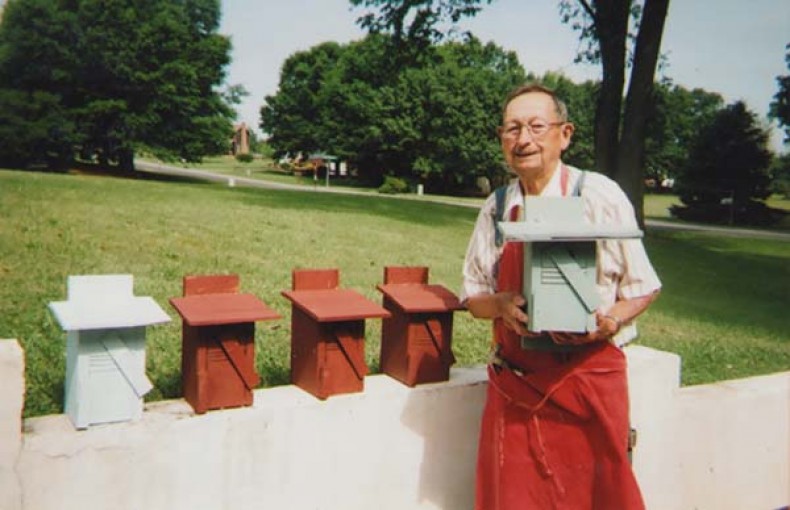The Barefoot feeder
How to make a Nyjer or thistle seed feeder

Charles Barefoot and his handmade bluebird nest boxes
Charles A. Barefoot Sr., a member of EnergyUnited who lives in Davidson County, is known for making nest boxes to house Eastern bluebirds. He gives them to people locally on request and asks payment only for materials and shipping. In February he began giving out some 200 bluebird boxes.

The completed thistle feeder
A native of Columbus County, Mr. Barefoot, 86, is retired after a professional career designing and producing electronic medical devices.
He has a new project that he described to Carolina Country.
"Each year I hang several thistle seed [Nyjer seed] feeders in my back yard for the goldfinches and other small birds. Some time ago I purchased a feeder that cost $20. More birds kept coming. I needed more feeders but I didn't want to spend a lot of money on feeders while I was also spending money for bags of seed. After giving this some thought, I set out to build my own thistle seed feeder. The feeder I designed turned out to be inexpensive, simple to build, and very effective."
Charles Barefoot's Thistle or Nyjer Seed Feeder
Supplies
- A 7-inch or 8-inch empty plastic jar, such as used for dry-roasted peanuts, with a screw-on lid about 3 inches in diameter
- Sturdy string or wire about 10 inches long
- 2 round wooden dowels ³/8 -inch diameter
- Tools
- Small drill or punch
- Saw
- Ice pick or small,
- pointed knife
Assembly (about 20 minutes)
Drill or punch a small hole in the center of the lid.
If using the string, insert it into the lid's hole and tie a large knot inside the lid, so the string cannot be pulled through it. Make a loop in the other end of the string about 8 inches from the lid. The loop is for hanging the feeder.
If using a 10-inch piece of wire, insert one end through the hole in the lid. Bend the wire, underneath the lid top, to form a loop about a half-inch wide so the lid cannot slide off. Make a hanger by bending and shaping a 2-inch or 3-inch loop on the other end of the wire.
Cut two 3/8-inch wooden dowels to 9-inch lengths.
Punch or drill a hole slightly smaller than the dowel on the side of the jar, about a half-inch from the bottom of the jar, running the punch or drill through to make an identical hole on the other side of the jar. Press a dowel through the holes in the bottom of the jar, leaving an equal length of the dowel protruding on each side of the jar. A tight fit is necessary to keep the dowels in the proper position.
About half way up the jar, punch or drill another hole all the way through the jar at a right angle to the lower dowel. Make sure the hole is slightly smaller than the dowel. Press the second dowel through the hole, leaving an equal length of the dowel protruding on each side of the jar.
Using an ice pick, small drill or pointed knife, make 1/8 -inch feeding holes in the plastic jar about 1½ inches directly above the center of each end of the dowels.
Fill the jar with Nyjer or thistle seed and hang it in a location, protected from the wind, where you and the birds can enjoy it.



Comments (2)
Anthony Robbins |
October 07, 2019 |
reply
Mark Fisher |
February 21, 2023 |
reply